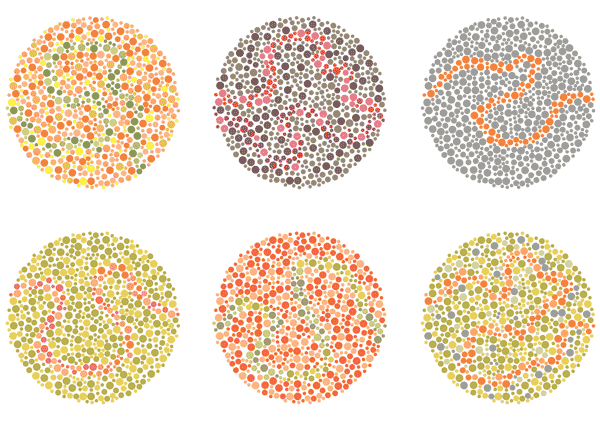A simple color blind test
It’s easy to test whether you’re color blind. You don’t even need to go to a doctor. A set of images called the Ishihara color plates is one of the most common and reliable color blind tests.
Simply look at the images, which have numbers embedded in dots of color. The numbers are a different color than the background. If you can’t see the numbers, you’re probably colorblind. School kids often take the Ishihara test as a classroom activity. Color blindness testing is that easy. And it can be fun.
But for anyone taking this test, it’s important to understand what it means to be color blind. The condition is uncommon and it’s rarely serious. Testing positive is no reason to panic.
“It very minimally impacts everyday life,” says Jane C. Edmond, MD, an ophthalmologist at Texas Children’s Hospital.
The term itself is a little misleading. With rare exception, people who are color blind don’t live in a colorless world. They see most colors clearly.
Color blindness occurs when cone cells, located in the retinal tissue at the back of the eye, don’t function or are damaged. There are two main kinds of color blindness:
- Red/green color blindness, the most common type, is congenital or inherited. It’s far more common in males than females, but still very rare. It affects 5 to 8 percent of males, and 0.5 percent of females. For people with red/green color blindness, reds and greens look similar to each other as a kind of brownish, muted tone. There is also a blue/yellow type of color blindness, but it's even more rare.
- A second, and less common, kind of color blindness is acquired, or related to an eye disease or condition. Retinal or optic nerve disorders are most likely to cause this kind of color blindness. In these cases, symptoms such as overall failing vision or persistent dark or white spots may be noticed first. An ophthalmologist may test for color blindness to help diagnose the problem. The doctor may start with an Ishihara screening test and, if that’s positive, move to more sophisticated testing.

Many versions of the Ishihara color blindness test have been produced. This example has lines that the person being tested can trace. This version of the color blind test works for people who cannot read letters or numbers.
Should You Be Tested for Color Blindness?
The American Academy of Ophthalmology doesn’t have formal recommendations for color blindness testing. You can have red/green color blindness and function well without even knowing it, according to Dr. Edmond.
“For the red-green patient, their visual acuity is totally normal, their eye exam is normal,” Dr. Edmond says. “It’s not part of most doctors’ routine screening.”
If there’s a family history of color blindness, or if you’re suspicious for yourself or your child, there’s no harm in taking the Ishihara test.
Dr. Edmond relays an anecdote of young children who would go wild strawberry picking. Their father said that his daughters always brought back plump red berries. His toddler son, however, would gather mostly brown leaves. With a family history of color blindness, the father tested his son, who turned out to be red/green color blind. He couldn’t distinguish between the brown leaves and the red berries.
The Ishihara test is named for Japanese ophthalmologist Ishihara Shinobu, a professor at the University of Tokyo who developed the screening in 1918 for the military. Though devised nearly a century ago, the Ishihara test is commonly used today and works for most people. In some instances, other tests are needed, such as for people whose eyesight is so poor they can’t see any of the image well, regardless of color. The military also uses more specialized testing.
Bottom line: Do the Ishihara color blindness test at home if you want. If you’re having noticeable vision problems that have come on suddenly or are getting worse and affect your color vision see your ophthalmologist for a check-up right away.